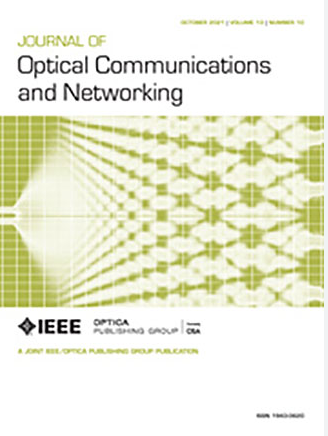研究文章 光通信与网络杂志 1 C+L 波段上 EON 的高效统计 QoT 感知资源分配:多周期和低利润视角
IF 4
2区 计算机科学
Q1 COMPUTER SCIENCE, HARDWARE & ARCHITECTURE
引用次数: 0
摘要
最近,多波段弹性光网络(MB-EON)被认为是提高光网络传输带宽的可行解决方案。为了提高频谱效率并降低阻塞率,必须在弹性光网络(EON)中使用的路由、调制电平和频谱分配算法中精确计算作为传输质量(QoT)指标的一般信噪比(GSNR)。由于信道间受激拉曼散射的影响及其宽光谱,通常用于单频 EON 的干扰预测方法在 MB-EON 中并不有效。在本文中,我们提出了一种考虑到多周期规划的统计方法来预测 C+L 波段 EON 中的干扰噪声。所提出的算法利用给定请求时每条链路上的预测信道总数(PTNC),是一种低成本、快速且经济有效的方法。此外,所提出的 PTNC 算法还可用于单周期规划。我们的仿真结果表明,所提出的 PTNC 算法结合了所研究的两种基准算法的优点。它的复杂度阶数和执行时间都很低,与目前网络运营商采用的满载算法相当。然而,该基准算法并没有达到最佳频谱效率。此外,PTNC 方法和另一种通过穷举搜索确定余量的基准(称为余量穷举搜索 (MES))能以较少的收发器实现出色的频谱效率和剩余容量,从而降低资本支出要求。不过,由于需要重新配置已建立的光路,且复杂度较高,MES 算法可能并不实用,特别是在多期规划中。本文章由计算机程序翻译,如有差异,请以英文原文为准。
Efficient statistical QoT-aware resource allocation in EONs over the C+L-band: a multi-period and low-margin perspective
Recently, multi-band elastic optical networks (MB-EONs) have been considered a viable solution to increase the transmission bandwidth in optical networks. To improve spectral efficiency and reduce the blocking ratio, the general signal-to-noise ratio (GSNR) as a quality-of-transmission (QoT) metric must be accurately calculated in the routing, modulation level, and spectrum assignment algorithms used in elastic optical networks (EONs). The interference prediction methods commonly used for single-band EONs are not efficient in the case of MB-EONs because of the inter-channel stimulated Raman scattering impact and their wide spectrum. In this paper, we propose a statistical method to predict the interference noise in C+L-band EONs considering multi-period planning. The proposed algorithm, which utilizes the predicted total number of channels (PTNC) on each link for given requests, is a low-margin, fast, and cost-effective method. Additionally, the proposed PTNC algorithm can also be used for single-period planning. Our simulation results indicate that the proposed PTNC algorithm combines the advantages of both studied benchmark algorithms. It has a low complexity order and execution time that are comparable to those of the fully loaded algorithm, which is currently employed by the network operators. However, this benchmark does not achieve the best spectral efficiency. Furthermore, the PTNC method and the other benchmark that determines margin through an exhaustive search, referred to as margin exhaustive search (MES), achieve remarkable spectral efficiency and residual capacity with fewer transceivers, resulting in lower capital expenditure requirements. Nevertheless, the MES algorithm may not be practical due to the requirement of reconfiguring established lightpaths and its high complexity order, particularly in multi-period planning.
求助全文
通过发布文献求助,成功后即可免费获取论文全文。
去求助
来源期刊
CiteScore
9.40
自引率
16.00%
发文量
104
审稿时长
4 months
期刊介绍:
The scope of the Journal includes advances in the state-of-the-art of optical networking science, technology, and engineering. Both theoretical contributions (including new techniques, concepts, analyses, and economic studies) and practical contributions (including optical networking experiments, prototypes, and new applications) are encouraged. Subareas of interest include the architecture and design of optical networks, optical network survivability and security, software-defined optical networking, elastic optical networks, data and control plane advances, network management related innovation, and optical access networks. Enabling technologies and their applications are suitable topics only if the results are shown to directly impact optical networking beyond simple point-to-point networks.

 求助内容:
求助内容: 应助结果提醒方式:
应助结果提醒方式:


